Nude in the Nettles: New Developments
by Tim Hicks and Chris Clark
~~~~~
Introduction
Some time ago, NYE writers Chris Clark and Tim Hicks started to investigate the “Nude in the Nettles murder”. One of the greatest murder mysteries in North Yorkshire.
Their investigation has made progress and they are now in a position to formally request that Peter Sutcliffe is designated as a suspect.
Background: The “Nude in the Nettles” Murder
On Friday the 28th of August 1981, North Yorkshire Police (NYP) officers from Thirsk responded to an anonymous telephone call and discovered the decomposing body of a woman at Sutton Bank, on the North York Moors.
Despite determined and relentless efforts, NYP have not been able to identify her. An appeal for information was made by NYP in 2011 as part of a cold case review gives the facts of the case as follows:
“An anonymous male caller telephoned North Yorkshire Police providing the exact location for police officers to search. On Friday 28th August 1981 Police officers attended the described location, a lay by on the unclassified road leading from Sutton Bank to the villages of Scawton and Rievaulx. The location is a quiet road used by local people and occasional caravaners heading to a nearby site. The rural area consists mainly of arable and pasture farmland with occasional conifer plantations. It was to the side of this road and between two small plantations that officers found the skeletal remains of an unknown female laid in undergrowth. This discovery marked the start of an 18 month police investigation led by Detective Chief Superintendent Strickland Maunsel Carter to establisher her identity and why she was there.
A forensic examination of the naked body revealed no jewellery or personal effects laid nearby that may assist in establishing who she was. A Home Office pathologist estimated she may have laid at that place situ for up to two years due to plant growth and state of the body. The post mortem did not establish a cause of death.
What could be established was that body was that of a female, 5’ 2” in height, aged between thirty five and forty and may have been a mother. The deceased appeared to have short dark coloured hair. There was evidence of an old fracture to the right ankle but nothing conclusive to provide an identification.
During the 18 month police investigation extensive enquires were conducted and a number of people were identified as possible matches for the deceased but none could be positively identified as the deceased.
A line of enquiry reported on at the time related to a female prisoner that had escaped from Askham Grange open prison almost two years earlier but has not been seen since or spoken to by police.
Thirty years later the same questions remain. The anonymous male caller that started this 30 years police investigation may have the answer to the other questions – who is this lady left undiscovered at the top of Sutton Bank?, what was she doing there? and how did she die.
The thirty years that have elapsed since the discovery of this lady has seen significant developments in police technology that are used in current police investigations, and possibly viewed as normal enquiries.
At the time a three-dimensional wax reconstruction of her head, which was first such reconstruction, indicated the investigators were keen to use new technology. It was a positive actions as the circulations of this image generated significant interest and possible identities but these failed to provide the identification required.
We need to recognise that at the time of her discovery the Police National Computer that holds vehicle and person details was in its infancy, The Automatic Number Plate Recognition (ANPR) had not been invented and the first mobile telephone call to be made in the UK would not take place for another three and half years.
Although the passage of time has changed police technology, North Yorkshire Police’s commitment to finding the answers to these questions remains the same, so that her family can have the answers they deserve. For this reason if you know the identity of the lady or the male caller please make contact.”
This appeal was closely coordinated with the local media, who were commendably supportive of police efforts to try and resolve the case. Article by Jennifer Bell of York Press here. The article obviously had police input and revealed additional information to that disclosed above. Four passages from the article are very relevant. The caller said:
“Near Scawton Moor House you will find a decomposed body among the willow herbs”.
It was a yoghurt top, discovered beneath the body, which gave police a vital timeline of clue of how long she had lain there –about two years.
The position of the body suggests someone was in a hurry to dump her.
Another popular theory was that the woman was a prostitute. But whoever she was police are convinced to this day that the cause of death was unnatural..
This triggered a major investigation by NYP which essentially fell into six phases from the discovery of the body in 1981 to the present. Serious errors were made in each phase and these are documented in numbered paragraphs below.
Phase 1 – (Detective Chief Superintendent Strickland Carter): Discovery of the body in 1981 until Crawley provided proof of life.
The investigation jumped to the conclusion that the victim was Geraldine Elizabeth Crawley, who was serving a three-year sentence for the manslaughter of an elderly woman in Liverpool. She had escaped from Askham Grange prison, near York in 1979 andwas known to have a history of joyriding up and down the A1 and A19. She was in fact alive and as a fugitive, she did not want the extra scrutiny of major police enquiries, in case they led to her detection and arrest. So she wrote to the police including her fingerprint on the letter to prove she was still alive. The Crawley red herring had a major effect on the investigation:
- A lot of police time was wasted focussing on the absconder as the victim, which would have been better spent following other lines of enquiry. It must be a concern that other potential victims were not properly or fully investigated, prior to the assumed victim coming forward and providing proof of life.
- Because the person initially assumed to be the victim had a history of joy riding up and down the A1 and A19, the investigation focussed on locations along the A1 and A19. Other than the deposition site on the A170, other routes may not have been so extensively covered. It should be said that geographical profiling was in its infancy at the time and was not a standard technique. The first use in the UK was in 1980 by Professor Stuart Kind during the Yorkshire Ripper investigation. Full story here.
- The investigation jumped to the conclusion that the initial caller was the murderer, although in fact there was (and is) no evidence to support this position and it is not credible to the authors. There were three sets of tracks leading to and from the body. Having gone to enormous effort and risk to transport the body by car to a remote rural location to successfully conceal it. Why should a murderer return to the scene of the crime in his car, examine the body three times that day and then ring in the location to the police? All the time knowing that if he or his vehicle was seen, by a passing motorist, it could lead to him being identified, arrested and imprisoned. Yet NYP relentlessly pursued the line that the caller was the murderer to this day.
- Having jumped prematurely to the conclusion that the mystery caller was the killer, the investigation -incredibly- then announced this publicly. Thereby ensuring that the caller -who no doubt was watching the publicity with interest- would not come forward. This is entirely understandable, because he would no doubt fear -with good reason- that he would be arrested and charged with a murder that he did not commit. Had an appeal for him to come forward on the basis that the police understood he was just an innocent passer-by and they would like him to help with details of how he found the body been made, he might have been persuaded to come forward. But the investigation missed this opportunity, preferring instead to go for a blaze of publicity by prematurely announcing it had a suspect.
- The possibility that the caller was an innocent person who had stumbled across the body and did not want to get involved in a murder investigation. Or that the caller was telling the truth when he stated that he could not reveal his identity or the circumstances of the discovery for reasons of national security, were ignored.
The authors suspect the mystery caller could have been a rambler. They have also identified six other people who could be the mystery caller and had a credible reason for to ring but withhold his identity for reasons of national security. Their deductions are as follows:
5.1 The mystery caller had a map and was able to extract a six figure grid. The report was made on a weekday in August (i.e. the annual holiday season) and the caller had knowledge of local plants. He was well spoken with a slight local accent. The implication being that he was a rambler or botanist walking locally or on a walking holiday. He did not want to ruin his holiday by having to spend it at a police station giving a statement and inevitably coming under suspicion. Then having to provide an alibi and possibly being arrested, then held overnight in a police station. Hence the reason he did not give his name.
5.2. Details withheld for legal reasons and reasons of national security.
5.3. Details withheld for legal reasons and reasons of national security.
5.4. Details withheld for legal reasons and reasons of national security.
5.5. Details withheld for legal reasons and reasons of national security.
5.6. Details withheld for legal reasons and reasons of national security.
5.7. Details withheld for legal reasons and reasons of national security.
- The autopsy could not identify how long the body had been there. There were two seasons of plant growth, which gave an estimate of two years, but based on surroundings, not the body’s condition. The investigation therefore used the sell by date on a yoghurt found underneath the body to date the time of deposition of the body. It did not consider the possibility that the yoghurt top had been put there deliberately by the killer to establish an alibi and confuse the investigation. The same tactic was used by Peter Sutcliffe in the murder of Yvonne Pearson in 1978, using a predated newspaper placed underneath her body as a ruse, to throw the investigation off track and establish a false alibi. If the victim was listed as a missing person, using the yoghurt top date as the basis of the elimination criteria may have resulted in the missing person being incorrectly eliminated from the enquiry.
- Because a) Yorkshire Ripper Peter Sutcliffe was in custody when the body was found and b) the police had prematurely designated the mystery caller as the prime suspect, the possibility that the murder could have been committed by Sutcliffe, or by any person other than the mystery caller was not fully considered in Phase 1 of the investigation.
- The Home Office pathologist could not determine the cause of death because of the state of the body after two years of decomposition. However, the autopsy revealed that:
-
- The skull was intact and did not show signs of Sutcliffe’s usual method of killing by bashing it in with a hammer.
- None of the bones had nick wounds from a knife attack.
- The throat area of the body was not recovered, probably because it had been removed by foxes. The pathologist was not therefore able to rule out ligature strangulation.
The investigation eliminated Sutcliffe because the skull was intact and designated the mystery caller as the prime suspect. This deduction ignored the fact that the absence of nick wounds from a knife on any of the bones does not necessarily preclude the possibility that the victim was stabbed to death. It is possible to stab someone to death without hitting a bone and leaving a trace of a knife attack on skeletal remains. Sutcliffe also used ligature strangulation and stabbing as a method of killing his victims:
- Debra Schlessinger was stabbed to death on the 21st of April 1977 without use of a hammer.
- Sutcliffe used a ligature in the attacks on Marguerite Walls on the 20th of August 1980 and Upadhya Bandara on the 24th of September 1980.
- When he was arrested in 1981, he had a ligature in his pocket.
It is clear that Sutcliffe should never have been eliminated as a suspect.
In summary, Phase 1 of the initial investigation focussed on an unfounded prime suspect and the wrong victim, adopted a media strategy that ensured the key witness would not come forward, probably used the wrong date of death and ignored a very good suspect – Peter Sutcliffe.
Phase 2 – (Detective Chief Superintendent Strickland Carter): Date Crawley provided proof of life, until the investigation was wound down in 1982
Once Crawley had come forward, the investigation re-focussed on identifying the victim, but was unsuccessful in this line of enquiry. It continued to maintain the position that the mystery caller was the murderer. This led to further errors:
- Sutcliffe was excluded from the investigation by HM Inspector of Constabulary Chief Constable Sir Lawrence Byford, which tried to identify other murders Sutcliffe may have committed. Had it not been, Sir Lawrence may have been able to identify it as a crime probably committed by Sutcliffe.
- Although Sutcliffe is known to have driven and operated all over North Yorkshire and was interviewed by NYP in connection with the attempted murder of a woman in Harrogate -which he denied. It appears that as a result of the focus on the mystery caller as the murderer, so far as is known he has never been investigated in connection with the “Nude in the Nettles” murder, even though it is consistent with his modus operandi, victim preferences, known area of operation and his occupation gave him a reason to be on the A19 making deliveries to Sunderland Docks and the A170 making deliveries to Scarborough.
- The victim was suspected of being a prostitute, but although many of Sutcliffe’s victims were prostitutes, this again did not lead to him being considered as a suspect.
The investigation was wound down in 1982 as a failure.
Phase 3 – 1982 until 2011
The file on the murder nevertheless remained open. The victim was probably murdered sometime in 1979 and the case was only three years old when the investigation was wound down, but it was ignored until 2011.
- As time goes on a killer becomes more confident and may feel the need to confide in another person or a partner. Loyalties can change resulting in someone coming forward. Yet there was no regular appeal for information on the case.
- So far as can be ascertained, there was no cold case review or attempt to progress the case until the thirtieth anniversary of the discovery of the body in August 2011. A gap of thirty years.
- So far as can be ascertained there has never been an external review of the case by an officer from another force.
In the authors opinion this was a serious failure, particularly as in this period the British Police Service as a whole was able to make enormous strides in improving the investigation of what became known as cold cases.
Phase 4 – (Detective Superintendent Lewis Raw): 2011 to the exhumation and interment of the body in 2012
In 2011, NYP issued an appeal for information about eight cold cases it felt were still solvable. The “Nude in the Nettles” Case was one of them.

Full details on all the above cases in Minster FM article here. If you have any information on any of the above cases, you can contact NYP, contact details here.
The 2011 investigation was led by Detective Superintendent Lewis Raw. In 2012, NYP exhumed the body and extracted DNA from it. This is covered in this Yorkshire Post article by Rob Preece. The exhumation was done with dignity and due reverence, with the NYP Force Chaplain in attendance.
This was a major success by succeeding in extracting DNA from the victim. Despite thousands of man hours of investigation by NYP since 1981, this was the only success in the entire sorry tale of this investigation. Both the UK National DNA Database and the Missing Persons’ DNA Databases were searched for a match. Some witnesses did come forward believing they knew the victim, but the body could not be identified. Press release here. Unfortunately this success was not fully exploited:
- NYP did not search British ancestry sites.
- The body was found on a road leading from a port – Scarborough. The possibility that the victim was a foreign national hitch hiking, or had been picked up in Scarborough having been dropped off in the port from a pleasure craft was not considered. So European DNA databases were not searched.
- NYP did not search any US genealogy sites to help identify the victim, although in the US, this is standard practice. The US databases use DNA supplied by the public to help find relatives and loved ones. They are also used by American police as they are free and open to all. US police forces compare crime scene DNA to samples on the database. If lucky, they get DNA hits linking a crime to a relative of a suspect, or the suspect himself. Genealogists use clues to construct family trees ultimately, they hope to identify a victim or convict a killer, rapist or paedophile. This approach resulted in the arrest of Golden State Killer Joseph James DeAngelo, aged 72, last year. He is suspected of killing 13 people and raping 50 women in California during the 1970s and 1980s. Chris has studied this case and its implications for UK policing:
“British police need to exploit the potential of publically accessible US DNA sites. I believe there needs to be a comprehensive check for familial DNA hits on British cold cases. The vast majority using these sites are American citizens, but that’s not a problem. Americans – or their family members in the UK – can move around and live abroad. A hit in the US can lead to the identification of a suspect in Britain”.
A DNA hit in the US could unlock stalled British murder probes where they have a DNA profile. Examples of cases that warrant a search of the US sites include:
- Exeter schoolgirl Kate Bushell, 14, killed while dog walking on 15 November 1997. Kate died after having her throat cut. Last year, Devon and Cornwall Police revealed they had a partial DNA link to another murder. Daily Mail article here.
- Kent Police also have a full DNA profile of the suspected killer of Wendy Knell, 25, found dead in a bedsit in Tunbridge Wells, on 23 June 1987. Wendy was sexually assaulted and beaten. Despite the DNA, police have never found a match. BBC article here.
The main DNA site used by the US police is GEDmatch, which has DNA from 1.2 million people. It can identify at least 60 per cent of all Americans of European ancestry. It was used in the Golden State Killer search. British citizens make up the fourth largest users in the GEDmatch database after the US, Canada and Australia. However, site co-creator Curtis Rogers said UK police currently do not use the DNA information it holds. He said forces would have to use expert genealogists to piece together any raw DNA leads:
“It takes a very experienced genealogist to do this and there are few of these. He said UK cops were free to access the site. Law enforcement can search through our database, that is how it works. They have to put genetic information on GEDmatch and then get information only about matches. There will not be direct matches. It is a long complicated process.”
Mr Rogers said he would welcome UK forces accessing DNA data held on GEDmatch:
“The victims go beyond the murdered and raped and beyond the family and friends of these people. It goes to entire communities and beyond. We have had overwhelming support for law enforcement use of GEDmatch. There have been emails from people who have suffered for decades and now have closure. There are probably hundreds and thousands of people who suffer like this.”
British genealogy sites have strict privacy rules and consequently are not used by the police. The failure to fully exploit the victims DNA reflects a failure by North Yorkshire Police to implement force policies that allow the use of British and foreign genealogy databases. It also demonstrates a wider overall failure of the British Police Service to implement policies that would allow the use of this vital source of crime solving information.
Chris was formerly an intelligence officer with Norfolk Police who has tried to progress this issue. The National Police Chiefs’ Council (NPCC) said there was no national policy for the forty three territorial police forces in England and Wales on using foreign sites. They said it was for individual forces to decide – but were not aware of any doing so. Chief Constable James Vaughan, the NPCC lead on forensic science, said:
“Nationally, there are no plans to use these sites. If an investigation opted to use this methodology, it would need to meet the relevant ethical standards.”
Chris has also emailed his concerns to UK forces. He received responses from Thames Valley and Sussex police.
- Thames Valley Police said: “The use of genetic genealogy is something that we are aware of. However, before it can be used in the UK courts, it has to be tested as to its accuracy. There is then the ethical question about using peoples’ DNA, who have provided it for a reason other than crime detection. My guess is it will be several months before we get answers as to whether we can use it.”
- Sussex Police said: “It is not something I have considered and of course there are ethical considerations to think about as well.”
In addition to being unable to fully exploit its successful extraction of DNA, the 2011/12 the second investigation made major errors:
- The second investigation may have been affected by misguided force loyalty. As well as being the lead officer on the first “Nude in the Nettles” investigation, Detective Chief Superintendent Strickland Carter was also the Head of North Yorkshire Police CID for many years. The most senior operational policeman in the force. I understand he was a most formidable character and was known as one of the top detectives in the British Police Service at the time. He was and remains, highly respected within NYP. Naturally serving police officers were reluctant in general terms do anything which may result in criticism of NYP and one of its most high profile senior officers. Consequently the 2011/12 investigation appears not to have taken a step back, impartially reviewed the previous investigation by Strickland Carter and admitted that it made major mistakes. In particular it maintained Strickland-Carter’s fatally flawed hypothesis that the killer was the mystery caller, even though there is no evidence to support this
- Detective Superintendent Raw appealed for the mystery caller to come forward. However, the press coverage was not explicit that he was no longer a suspect (because he obviously still was). Consequently, the mystery caller understandably chose to maintain his silence, no doubt for fear of being arrested and charged with murder, or of obstructing the investigation. Then of being castigated in the press as a murderer even if he was not convicted. In summary, the media strategy followed by both investigations was counter-productive, because it intimidated a key witness from coming forward.
- Peter Sutcliffe was not considered as a suspect in this murder, even though it is consistent with his modus operandi, victim preferences, known area of operation and he had a reason to be on the A19 and A170. Because the second investigation maintained Strickland-Carter’s view that the killer was the mystery caller.
Interestingly, the NYE has had occasion to review Strickland Carter’s performance before. As a Detective Inspector, Strickland-Carter was the Head of Scarborough CID during the period when Peter Jaconelli and Jimmy Savile were abusing children at will in Scarborough and Whitby. BBC investigation here. Apology by Assistant Chief Constable Paul Kennedy for the inexcusable failure of Scarborough CID to arrest Savile and Jaconelli here.
North Yorkshire Police recently refused to respond to a Freedom of Information request asking for confirm that Peter Jaconelli was an informant for Scarborough CID, to identify how much was paid to him or to name his handler. Their excuse for this was that it would prevent the investigation of crime. Clearly this is untenable. Naming Jaconelli as a police informant twenty years after he died will not put his life at risk, damage any ongoing investigation or reveal police methods. It simply prevents further clarity on why NYP protected Jaconelli and allowed him to abuse children with impunity. Detective Chief Superintendent Strickland Carter has never commented on this failure to arrest Savile and Jaconelli. Nor has he faced any investigation, censure or disciplinary action over his performance during this period of his career.
Phase 5 – Press coverage of Chris Clark’s work on the case 2013
Chris had studied the “Nude in the Nettles case” and concluded that Sutcliffe should be considered as a suspect. This led to media coverage. York Press article here. York Press contacted North Yorkshire Police about this line of enquiry. Needless to say:
- North Yorkshire Police did not contact Chris or follow up on the information he had gathered. Its excuse for this was that he had not contacted them, conveniently ignoring its duty to be proactive and exploit all available lines of enquiry
Phase 6 – The NYE takes up the case and asks Chief Constable Winward to re-open it
Further errors are still being made. The authors have meticulously examined all of the evidence available on the “Nude in the Nettles” murder and concluded that Peter Sutcliffe should be considered as a suspect. They have run several articles on the case, each of which contains an appeal for information. One of the appeals produced a witness who believed she knew the victim, but after a diligent investigation by the NYP Cold Case Unit, the alleged victim was traced and eliminated from the investigation.
Despite this:
- We are aware that officers from NYP read the NYE, however, NYP did not contact us to follow up on our information and so far as we can ascertain did not interview Sutcliffe about the murder.
- In cold cases, the two most important factors in progressing them are advances in forensic science and media coverage. As narrated above, NYP have very skilfully exploited advances in forensic science and extracted the victim’s DNA. That leaves the second factor, which is media coverage. Tim suggested a joint media appeal on the anniversary of the discovery of the body in August 2019, (thirty eight years after the discovery and about forty years after the murder). Being realistic, the fortieth anniversary will be the last opportunity to resolve the case, because if its age. But incredibly this has not yet been responded to.
The investigation of this crime has been permanently afflicted with the consequences of the initial mistakes made by the 1981 investigation and the refusal of NYP to face up to them. It may still be resolvable. But it can only be resolved if the investigation is subjected to an impartial review and re-focus.
Normally a cold case detective will do anything he or she can to generate media coverage, in the hope of producing a lead that will progress the case. In the “Nude in the Nettles” case, the opposite has occurred. The NYE has been solidly ignored and stonewalled by North Yorkshire Police. So why is this? Tim believes it is due to a number of factors:
- Misguided loyalty: NYP guards its reputation jealously and would never admit to having bungled a major investigation, or that it missed a blatantly obvious suspect for thirty eight years. Particularly when that suspect is the Yorkshire Ripper and this revelation will damage the reputation of a senior retired police officer, and the force.
- Bureaucratic intransigence: The police are authority figures and used to laying down the law to other people. They will not accept being publicly challenged, or having failures pointed out to them by anyone. Especially on a high profile murder case.
- Personal Animosity: The NYE has publicly exposed NYP failures in the Peter Jaconelli scandal and criticised Chief Constable Winward personally. This has led to a petulant refusal to work with the NYE, although it is a leading local media outlet.
Hence perhaps the determination the authors have encountered not to cooperate with the NYE, exploit its media coverage, review the conduct of the investigation, or consider Sutcliffe as a suspect.
Some will argue that there is no point in re-opening a murder investigation that is forty years old. The authors would argue that an investigation should remain open and continue to follow up lines of enquiry if it is a case of no body, an unidentified body or if the perpetrator could still be alive. This is to provide the deceased with a proper burial, provide some relief to the relatives and ensure the interests of justice are met by punishing the murderer. As an example consider today’s news (28th of May 2019) that Police Scotland have started draining Leancach Quarry, in their efforts to resolve the murder of Renee MacRae and her infant son Andrew aged three, who were last seen driving out of Inverness on November 12, 1976. BBC report here.
We know that many police officers read the NYE. This article is highly critical of the conduct of a high profile investigation into a serious crime conducted by their force and its senior command team. Many of them will reject the authors analysis above as “police bashing”. The authors deny this and assert that any impartial observer would conclude that serious errors were made at every stage of this investigation. As journalists, it is our duty to hold the police to account and to expose failings in the service the police provide to the public. This article tries to expose the shortcomings in the investigation, so that lessons are learned and even at this late stage, the murder of this poor unfortunate woman is fully investigated and – if possible – progressed to a successful conclusion.
Formal request for Sutcliffe to be interviewed as a suspect
On the 11th of May 2019, Tim wrote to Chief Constable Winward formally requesting a review of the case by another force and that Sutcliffe is interviewed under caution in connection with this offence.
Tim has also written with a Freedom of Information Request asking for access to the Nude in the Nettles file.
The NYE will continue to cover this case and keep readers updated with developments.
Chief Constable Winward has received a draft of this article and been given the opportunity to comment. She has also been asked to confirm NYP force policy on access to foreign and UK Genealogical databases. She has chosen not to comment.
Further Reading
NYE articles going into greater detail on Sutcliffe and the “Nude in the Nettles Case” here and here.
NYE article on the Harrogate attack which Sutcliffe was questioned about by NYP here.
NYE articles going into greater detail on Sutcliffe here and here.
NYE Appeal for Information
The Mystery Caller:
If you are the mystery caller and want to come forward in confidence to a journalist, so that this matter can be removed from your life. If you know who he is, you can also come forward to a journalist.
Please contact the NYE using our letters@nyenquirer.uk address. All responses will be treated in the strictest confidence.
The Victim:
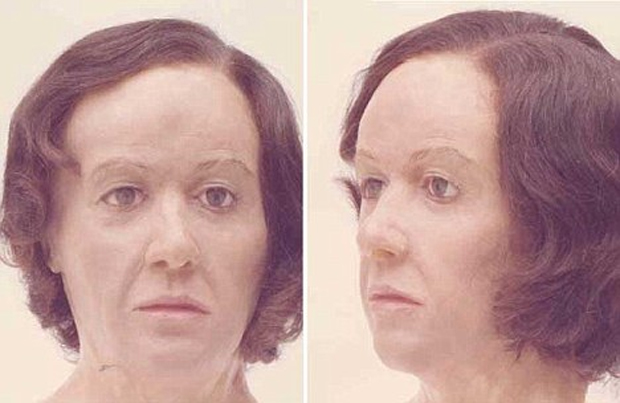
Three-dimensional wax reconstruction of the victim’s head and face
- She was 5’ 2” in height, aged between thirty-five and forty.
- She had a slender build and wore her natural dark brown hair in a page-boy style.
- She had given birth to two or three children and had a displaced septum between her nostrils.
- Her toenails were painted pink – the varnish coming from the Max Factor Maxi range.
- She would have worn a size 4 shoe.
- Staining on her teeth revealed that she was a heavy smoker that did not look after herself.
- All her upper teeth were missing, she had an upper dental plate fitted, and she had only six lower teeth.
- She had an old fracture to her right ankle and an abnormality to her neck vertebrae which would have caused backache.
To jog memories, 1979 was the year Margaret Thatcher was elected, the Ayatollah Khomeini returned to Iran, “Heart of Glass” by Blondie and “I Will Survive” by Gloria Gaynor were in the charts.
- Do you remember someone like this from 1979?
- Did she come into Scarborough or Whitby on a yacht?
- Did you see her hitch hiking?
- Did you see her in a truck stop on the A19, at the A1 Services at Boroughbridge, the A168 at Thirsk, or the Leeds, Manchester, Halifax, Bradford, Sunderland, Darlington, Hartlepool, Middlesbrough or Newcastle red light districts?
- Did you see her walking on the North York Moors?
The NYE’s suspect: Peter Sutcliffe:
Peter Sutcliffe pictured in his TW Clark lorry circa 1976
- Did you see Peter Sutcliffe or a lorry from TW Clarke (image above) in Scarborough or any of the above locations?
- Did you see anyone behaving suspiciously along the A170 or at Sutton Bank in the period 1978 to August 1981?
- Did you find women’s clothes discarded along the A170 in 1979?
If you have any information on the “Nude in the Nettles” mystery that you want to pass on confidentially, you can talk to a journalist by initially contacting the North Yorks Enquirer using our letters@nyenquirer.uk address. All responses will be treated in the strictest confidence.

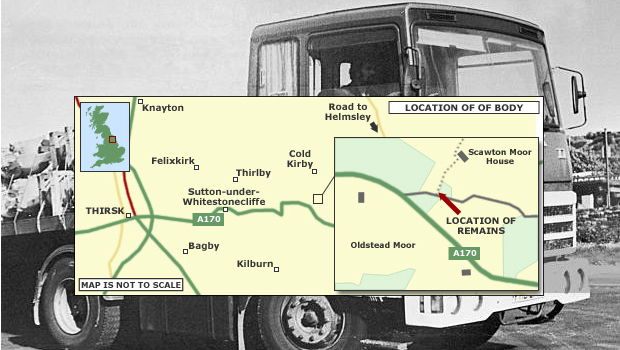



![Death of Sir Lawrence Byford [Obit.]](http://nyenquirer.uk/wp-content/uploads/2018/02/SIR_LAWRENCE_BYFORD-150x150.jpg)


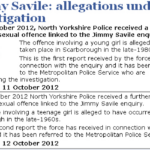

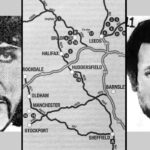
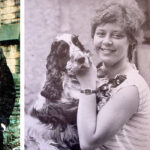
















Comments are closed.